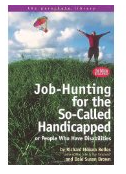Books By Dick

What Color Is Your Parachute 2016
In 2009, the most recent year for which I have these figures, out of the 1000 business books that were published that year, only 62 sold more than 5,000 copies. According to BookScan, this is typical. The average non-fiction book now sells less than 5,000 print copies in its entire lifetime. By contrast, “What Color Is Your Parachute? A Practical Manual for Job-Hunters and Career-Changers” has sold over 10,000,000 print copies. More than ten thousand people buy the book each month. It is a New York Times best-seller, having spent 288 weeks on the New York Times Best-Seller List (paperback).
Parachute, (as it is often called for short) was first published in 1970. It was self-published, at a local copy shop in San Francisco. In 1972, Ten Speed Press, a small publishing house (at that time) in Berkeley, California, bought the commercial publishing rights to it, and agreed to publish a new edition of it every year. It quickly shot to the top of best-seller lists across the country, and soon became the best-selling job-hunting and career-changing book in the world. That has continued for the past 45 years. It is in 20 languages now, used in 26 countries around the world. Asked to explain its popularity, the author, Dick Bolles, said: "No job-hunting book should sell over 10,000,000 copies. It reveals some kind of vacuum in our educational system, which leaves graduates hungry for the knowledge the school should have given them: how to plug in what they learned in the classroom, to real needs out there in the world of work."
The themes of the book are: there is a different job-hunting system out there, other than the traditional one of resumes, ads, and agencies. This alternative job-hunting system begins with a self-inventory, first deciding who you are before deciding the kind of work you want to pursue. The basic questions to be addressed, concerning who you are: are WHAT, WHERE and HOW. What do you most love to do, described in terms of the basic transferable skills you most love to use? And in order to do your most effective work, where would you most love to use those skills, geographically, and with what knowledges, for what purpose, with what target audiences, in what kind of an organization? And howdo you discover the names of such jobs, and how do you approach organizations which have such jobs in your preferred geographical area, even when they do not have a published vacancy at that moment?
Each new annual edition of Parachute incorporates the latest changes in the nature of the job market, the latest changes in how employers go about hiring, new technologies, how to start your own business, and the nature of job-hunting. The author does voluminous research on these topics all year round, and maintains active conversations with hundreds of job-hunters and employers. Writing each new edition typically takes three months, from January through March. Each new edition appears in bookstores and online around August 12 of each year, dated as of the following year (e.g., the edition first appearing on August 12, 2015, is called the 2016 edition)
In 1995, the Library of Congress' Center for the Book listed Parachute as one of “25 Books That Have Shaped Readers' Lives” (alongside such works as Maya Angelou's “I Know Why the Caged Bird Sings,”Saint Exupery's “The Little Prince,” Henry Thoreau's “Walden,” Cervantes's “Don Quixote,” Tolstoy's “War and Peace,” and Mark Twain's, “The Adventures of Huckleberry Finn”).
The author coined the word “parachute” to mean choosing or changing a career, because back in 1968 people commonly said, “I'm fed up with this job - - I'm going to bail out?”; Bolles' rejoinder at that time: What color is your parachute? later became the playful title of the book.
Reviews have called it “the jobhunter's Bible,” “the Cadillac of job-search books,” “the most complete career guide around,” and “the gold standard of career guides.”
The book is still published by Ten Speed Press, but that Press was sold a few years ago, by its dying owner, Phil Wood, to Random House, which merged with the Penguin Group in 2013, so the back of its title page now reads "Published in the United States by Ten Speed Press, an imprint of the Crown Publishing Group, a division of Random House LLC, a Penguin Random House Company, New York."
The current edition (2016) has 353 pages, and is priced at $19.99 in U.S. bookstores, $25.99 in Canada. Online, at either Amazon ($11.99) or Barnes & Noble ($12.22). (Readers tend to prefer the print version to digital, as some of the exercises are very interactive).
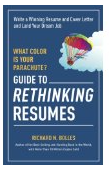
Rethinking Resumes
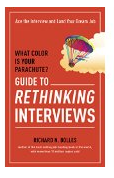
Rethinking Interviews
Job Hunter's Workbook, 4th edition
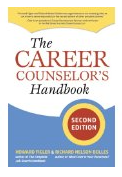
The Career Counselor's Handbook, 2nd ed.
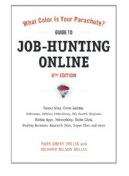
Guide to Job-Hunting Online
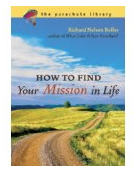
How to Find Your Mission in Life
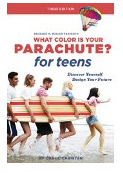
What Color Is Your Parachute for Teens
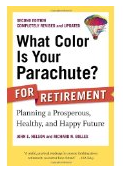
What Color Is Your Parachute for Retirement
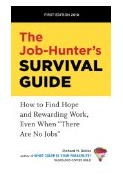
The Job-Hunter's Survival Guide
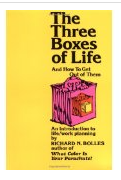
The Three Boxes of Life and How to Get Out of Them
